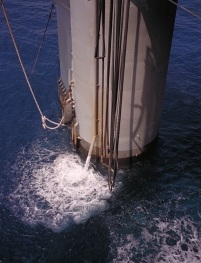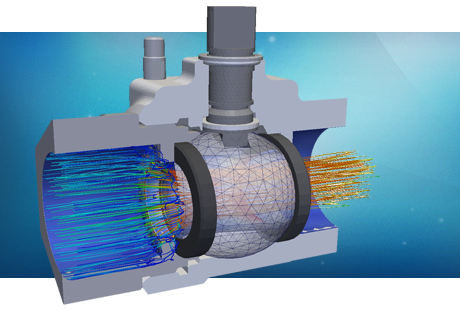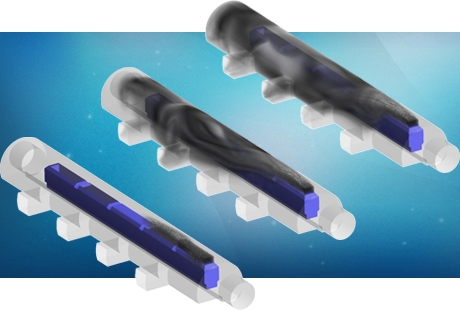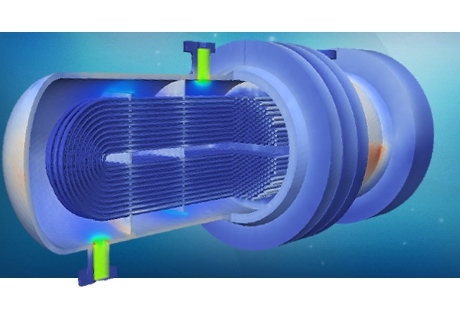Water treatment
In an oil and gas development water may come from different sources and is usually treated either for disposal or for well injection (as liquid or steam). Generally speaking a water treatment facility will collect produced water from the separators and coalescers and deliver it to a sand cyclone, which separates out most of the sand which is further washed before it is discharged.
 The water then goes to a centrifugal separator, normally a hydrocyclone, which will separates oil drops. Finally the water is collected in the water de-gassing drum where dispersed gas will slowly rise to the surface and pull remaining oil droplets to the surface by flotation. At this point the produced water can be discharged to sea and recovered oil is typically recycled to the third stage separator.
The water then goes to a centrifugal separator, normally a hydrocyclone, which will separates oil drops. Finally the water is collected in the water de-gassing drum where dispersed gas will slowly rise to the surface and pull remaining oil droplets to the surface by flotation. At this point the produced water can be discharged to sea and recovered oil is typically recycled to the third stage separator.
Each treatment process has its own technological challenges and uses very different processing equipment. Whatever the process technology the use of CFD and FEA modelling is a great advantage for designers and operators. Valuable insight on the fluid dynamics performance, separation efficiency and mechanical aspects such as stress, fatigue and erosion can be obtained at a fraction of the time and cost required to complete similar laboratory trials.
Dispersed oil removal

Well-produced water is normally contaminated with all kinds of dissolved organic matter, such as aliphatic hydrocarbons, phenols, organic acids, aromatic compounds, such as benzene and toluene or even hydrocarbon discharges. The removal of these compounds takes sound engineering and the use of very specific equipment. However all separation ultimately relies on the same principles: Cyclonic and centrifuge separation, gravity separation, flotation and filtration. Bespoke water treatment systems can be quickly assessed using multi-phase CFD modelling on a battery of tests that is representative of critical operational scenarios.
De-oiling hydrocyclones provide the highest throughput-to-size ratio of any water-treating technology and are insensitive to motion or orientation. That is why they are the preferred option in most installations. However the technology is constantly evolving and there are aspects that are still in need of improvement. Poor efficiency due to the lack of fluid-pressure energy is one of the main issues in modern hydrocyclone installations. This is due to the pressure loss across the distance from the mixture inlet to the treated water outlet and is normally solved by adding a pumping device upstream. Low shear pumps are needed such as progressing cavity or positive displacement pumps. CFD analysis may help the designer determine the effect of the pumping device, proportional and overflow valves and inlet configurations on the droplet dispersion, thus aiding the optimisation of the cyclone efficiency.
Disc-stack centrifuges are a good alternative to hydrocyclones for produced-water clean-up. They are used primarily for difficult applications where the fine-oil droplets do not coalesce easily. Due to the complex dynamics of the centrifuges, designers must carefully consider the mechanical and fluid dynamics response of the different elements of the system such as the separator bowl, inlet and outlet devices and the power devices (frame, drive motor and transmission). Extreme accelerations (up to 6,000 g-forces) and large rotation speeds make these devices suitable candidates for advance analysis such as CFD and FEA analyses especially in areas such as stress analysis, vibrations analysis and expected fatigue life.

Our white paper on cyclonic separation can be found here.
Gravity separation is completely different in nature to centrifuges and cyclones. It is governed by Stokes’ law which is used to define the steady buoyant rise velocity of a discrete oil droplet in a continuous water phase. Engineers must consider a number of physical aspects when designing gravity separators. Factors such as continuous phase viscosity variations with temperature, range of discrete droplet diameters and emulsion stability have to be taken into account because they dramatically influence the separation performance.
PRE Technologies possess large experience in multi-phase CFD analysis applied to different types of separators. Examples of devices where CFD modelling has been successfully applied are skim vessels, API separators and plate coalescers. Mathematical modelling can help the designer understand not only the process variables and their relevance, but also the impact of external conditions such as vibration and sloshing which arise from marine dynamics in the offshore operating environment.
Our white paper on gravity separation can be found here.
Gas flotation units do not rely on gravity forces for separating the oil droplets. Moreover the action of these units is independent of the oil-droplet size. In gas flotation units, large quantities of small-diameter gas bubbles are injected into the water stream. The bubbles attach to the oil droplets suspended in the stream, causing them to rise to the water surface and form a froth layer. Again features such as gas dispersion, bubble size and gas/water flow rates can be optimised using multi-phase CFD models.
Material selection
Another critical aspect of any water treatment facility is the material selection for the different equipment and piping. The designer must take into account a number of important factors, such as the pressure rating of the application, the corrosivity and the erosivity of the fluid to name just a few.

Erosion protection is an engineering discipline in itself. Erosion mechanisms (impact and sliding abrasion) are normally at play in water treatment equipment and knowledge of the expected wear rate is often valuable to analysts when selecting the materials for various applications. CFD based erosion analysis has proven to be a valuable tool in aiding the prediction of erosion hot-spots as well as wear rates, enabling the designers to save costs and prevent failure of these often complex and demanding devices. PRE Technologies team are experienced in carrying out erosion calculations on equipment made up of common materials such as carbon-steel and stainless-steel, as well as commonly used erosion-proof materials such as white iron, alumina (Al2O3), silicon carbide (SiC) or tungsten carbide (WC).
Our white paper on particle erosion can be found here.
For more information on other services for processing systems, please go to the processing services tab or contact us here.
Our services for this sector
Oil removal
-
Hydrocyclones
- ASME and API compliance assessments for hydrocyclone devices
- Optimisation of hydrocyclone's fluid dynamics using CFD modelling
- Hydrocyclone stress and fatigue FEA calculations
-
Centrifuges
- ASME and API compliance assessments for disc-stack centrifuges
- Centrifuge stress and fatigue FEA calculations for high rotation speeds
- Optimisation of centrifuge's fluid dynamics using CFD modelling
-
Gravity separation
- ASME and API compliance assessments for gravity separation vessel
- Optimisation of separator's fluid dynamics using CFD modelling
- API separators and plate coalescers stress and fatigue FEA calculations
Material selection
- Erosion prediction using CFD modelling
- CFD corrosion models for pipeline dimensioning
- ASME and API compliance assessments for different material grades







